This post may contain affiliate links. If you use these links to buy something we may earn a commission. Thanks.
The low-growing ground covers in this list thrive in shade and some even tolerate walking traffic! Carpeting plants are chosen for all sorts of reasons and each plant serves these functions in one way or another.
Low-growing ground covers can offer a beautiful green landscape, a living mulch effect, a walkable carpet, a contrast from taller growing perennials, a weed suppressor, a lawn alternative, and a fill between the cracks of tiles or rocks.
Related: Best Walkable Ground Covers for Shade (In Order)
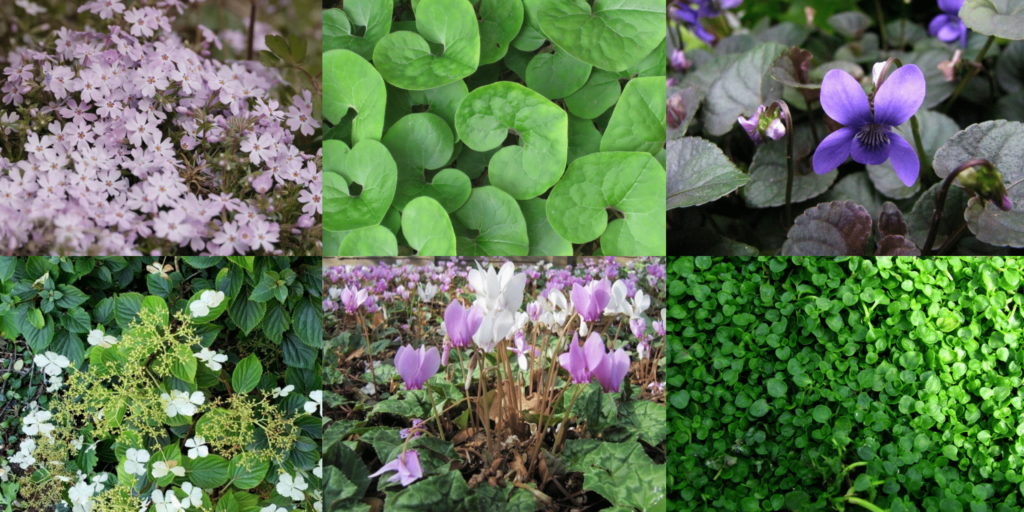
For more options and functions see all the best ground covers that grow in zones 3-6.
Start here: Best Zone 6 Ground Covers for Shade (With Pics)
Redwood Sorrel (Oxalis oregana)

Redwood sorrel makes a great woodland, native, or food forest ground cover as it is good at competing for ground space. It often needs weeding in its first year, but after that will maintain its territory—suppressing other weeds. This low-growing ground cover has cute foliage that lifts and lowers with the light of the day.
With the ability to grow in all light levels, you can plant this as a consistent ground cover throughout the landscape, if desired.
Some say this plant grows invasively. For an edible ground cover, however, an aggressive nature means more food for you or the garden!
- Height: 2-4 inches.
- Range: Native to Western North America
- Climate: Zones 6-9
- Functions: Edible ground cover is often added to food forests. Dense carpeting ground cover for any amount of light.
- Light requirements: Full, semi, or no shade.
- Soil preferences: Moist soil from light to heavy texture.
This variety can be bought as a plant or seed here.
Cyclamen (Cyclamen hederifolium)
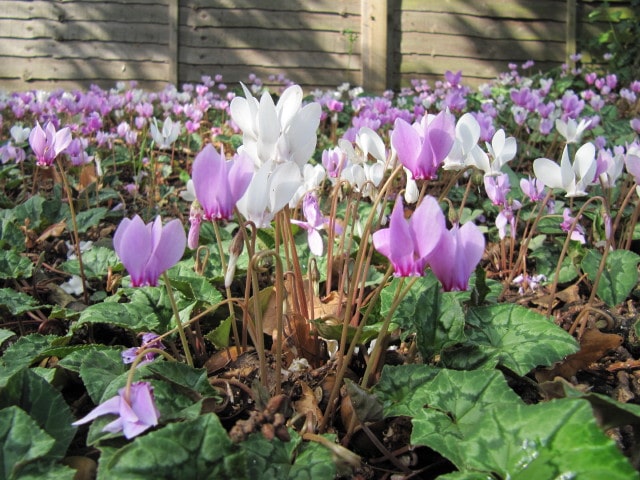
For shaded or lightly shaded rocky areas, cyclamen thrive in light, medium, or rocky soils. They have delicate flowers, an ornamental appeal, and are great in rocky areas.
- Height: 4-6 inches
- Range: Native to Europe
- Climate: Zones 6-9
- Functions: Attractive ornamental ground cover for deer/rabbit resistance.
- Light requirements: Full, semi, or no shade.
- Soil preferences: Moist soil.
Seeds are available here.
Creeping Saxifrage (Saxifraga stolonifera)

This edible ground cover is sometimes used in shady rock gardens for its interesting foliage and dense spread. This ground cover prefers partial shade and is often planted in areas with clay soil as few other options are best.
- Height: 6 inches
- Range: Native to Asia
- Climate: Zones 6-10
- Functions: A popular edible ground cover in woodland gardens, borders, or rocky areas. Dense ornamental foliage.
- Light requirements: Partial shade
- Soil preferences: Moist and light to heavy soils.
Many varieties are available for your choosing here, just ensure it is hardy to your zone and grows in partial shade.
Pine phlox (Phlox nivalis)
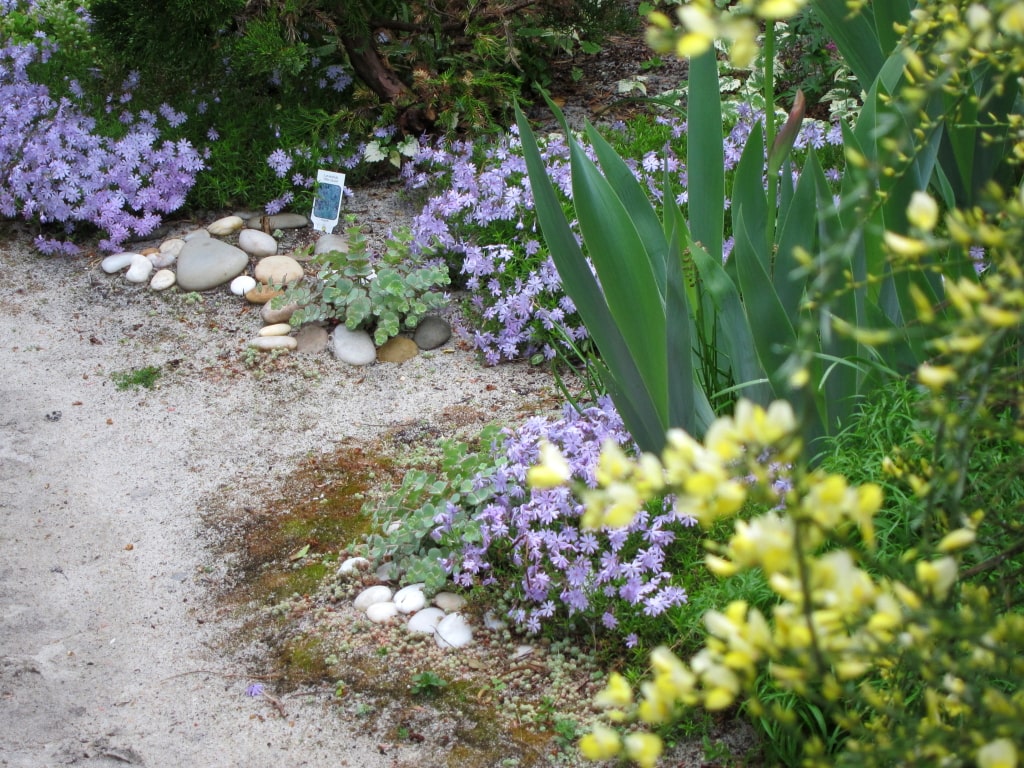
This trailing phlox is a popular ornamental ground cover choice in a lot of zones. This specific trailing phlox is only hardy to zone 6. Other options, however, are also available to you (one below) and are hardy to colder temperatures.
This trailing phlox is particularly low-growing and crack-filling, compared to other clumping types. Phlox is often chosen for its profuse flowering and dense growth habit.
- Height: 6 inches
- Range: Native to North America
- Climate: Zones 6-9
- Functions: A popular flowering ground cover in food forests and general gardens.
- Light requirements: Partial or no shade
- Soil preferences: Moist or dry light sandy soils are best for their fibrous and fine root systems.
Phlox is very easy to source in containers or as seeds. Nature Hills offers just a large of selection and coloring as Etsy sellers.
Moss phlox (Phlox subulata)
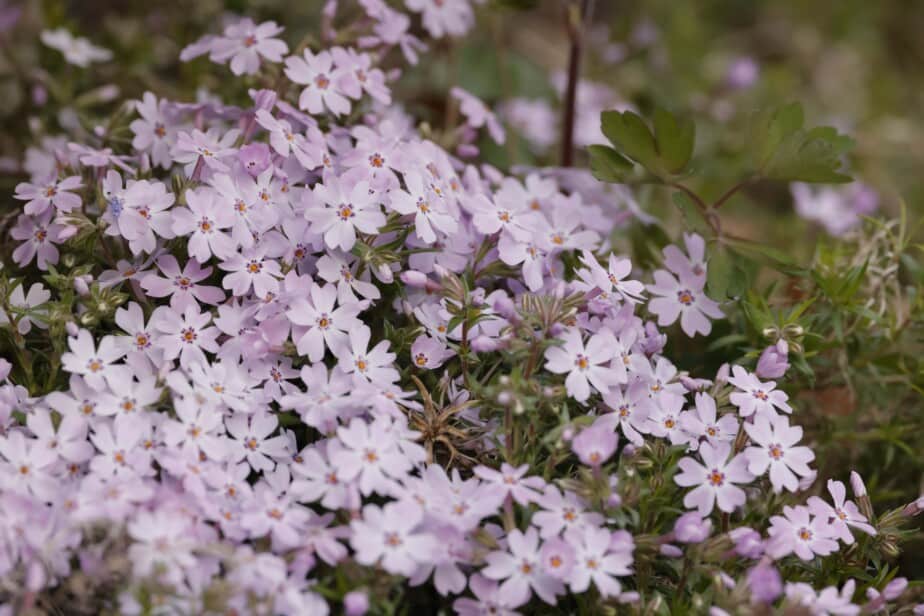
Moss phlox is a popular flowering ground cover as it’s highly adaptable to various conditions, grows fast, and looks great.
- Height: 4-6 inches.
- Range: Native to North America
- Climate: Zone 3-9
- Functions: Erosion control. Soil building. dense ground coverage. Ornamental flowers from April to May.
- Light requirements: Partial shade to light shade or full sun.
- Soil preferences: Dry or moist soil.
A wide variety of colors to choose from here.
Squaw Carpet (Ceanothus prostratus)
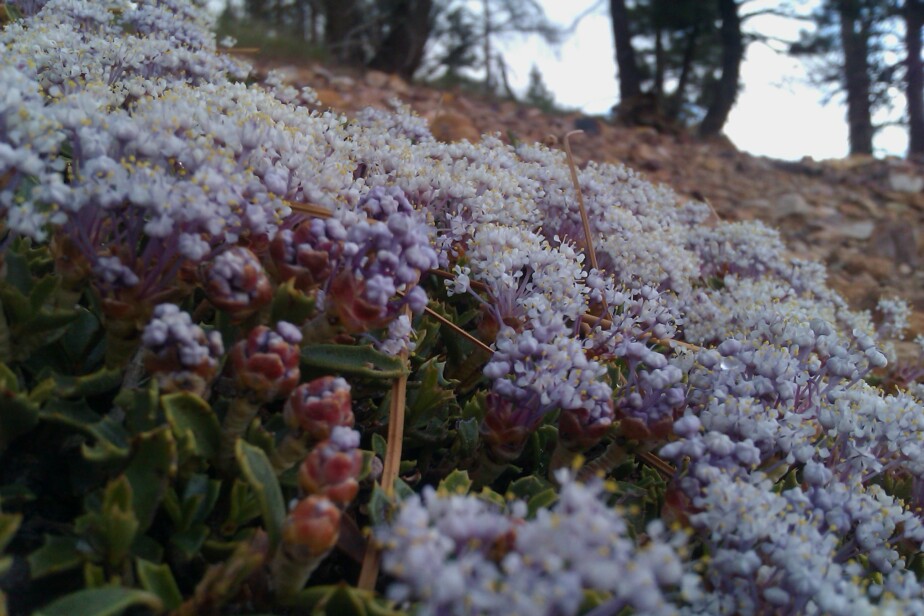
Squaw Carpet loves warmth but tolerates partial shade. Pollinators love their flowers from April to May.
This makes a lovely living carpet with nitrogen-fixing capabilities.
- Height: 6 inches
- Range: Native to Western North America
- Climate: Zones 6-9
- Functions: Nitrogen fixer. Pollinators.
- Light requirements: Partial or no shade
- Soil preferences: Moist or dry soils.
Seeds are available here. Once you plant and establish this ground cover, its best to leave it be without disturbance.
Loce Restorer (Sedum anacampseros)

This is one of few sedums that can thrive in partial shade, but I would advise against a full shade position.
- Height: 3-6 inches, and up to 8-10 inches when flowering
- Range: Native to Europe
- Climate: Zones 5-9
- Functions: Edible and ornamental succulent leaves but primarily grown for ground coverage purposes.
- Light requirements: Partial or no shade.
- Soil preferences: Dry or moist soil and drought tolerant once established. Suitable for heavy clay.
If you’re set on a succulent ground cover for shade, be sure to select a variety that is known for tolerating shade. Succulents in general prefer full sun, but some varieties, like Loce Restorer, love partial shade too.
Nature Hill’s Nursery offers about 7 varieties of sedums (from green to pink) that grow in partial shade. Go here and ‘check’ the ‘partial shade’ box to be sure you’re looking at the right options!
Corsican Mint (Mentha requienii)
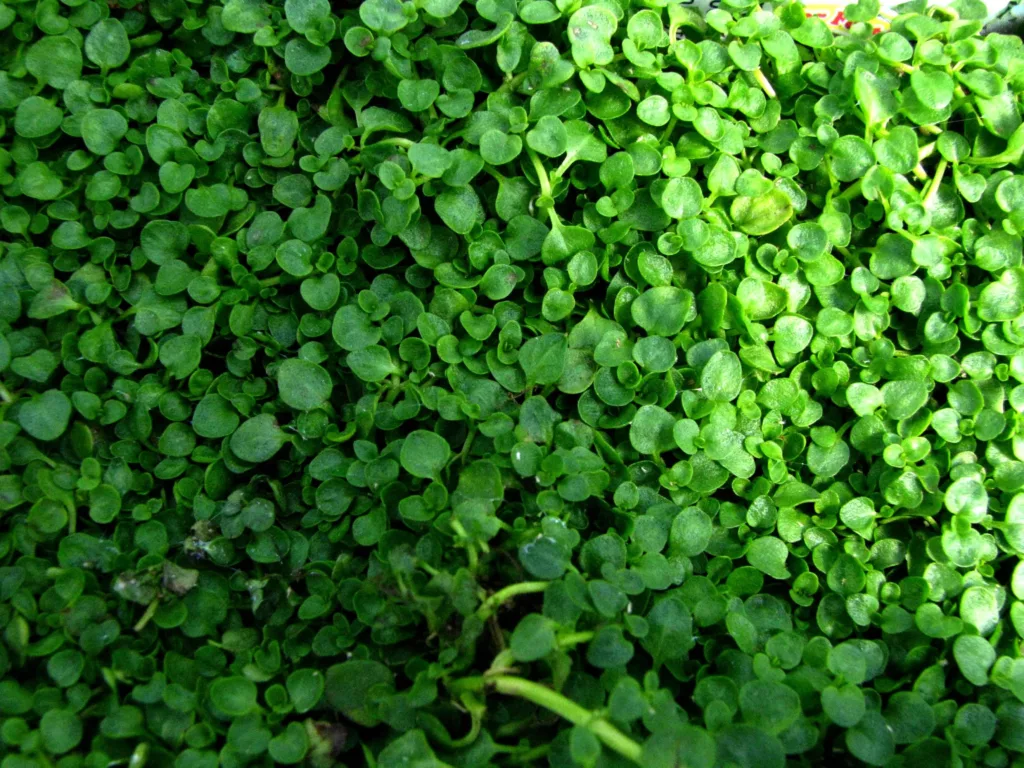
An increasingly popular ground cover for its fragrance and cuteness. It smells very much like peppermint and is edible in the same ways.
Unlike a lot of mints, this type prefers partial shade over full sun as it grows very low to the ground and dislikes dried soil.
This ground cover tolerates walking traffic! This mint has been a candidate to replace small areas of lawn.
- Height: 1-2 inches
- Range: Native to Europe
- Climate: Zones 5-9
- Functions: Scent-confuser to prevent pest issues and attract a variety of wildlife and overall balance. Flowers attract beneficial pollinators—bees and butterflies from July to August.
- Light requirements: Partial shade.
- Soil preferences: Moist soil. suitable for heavy clay.
Seeds are available here.
Mottled Wild Ginger (Asarum shuttleworthii)
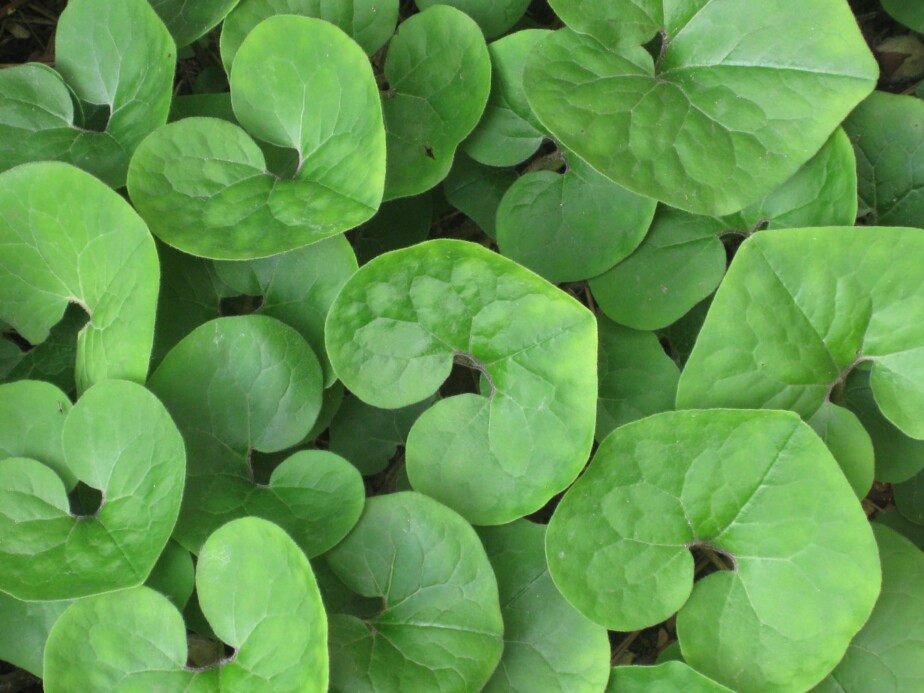
If you’re all about ginger (and sticking to native species), this variety is native to North America and also thrives in the fullest of shades.
Gorgeous foliage fills in rock gardens and is also suitable for clay soil.
- Height: 4 inches
- Range: Native to North America
- Climate: Zones 5-9
- Functions: Fragrance, rock gardens, and edible polycultures.
- Light requirements: Full shade or partial shade.
- Soil preferences: Moist soil and good drainage. Suitable for heavy clay.
You’ll find wild ginger available by seed or root here.
Wild Ginger (Asarum canadense)
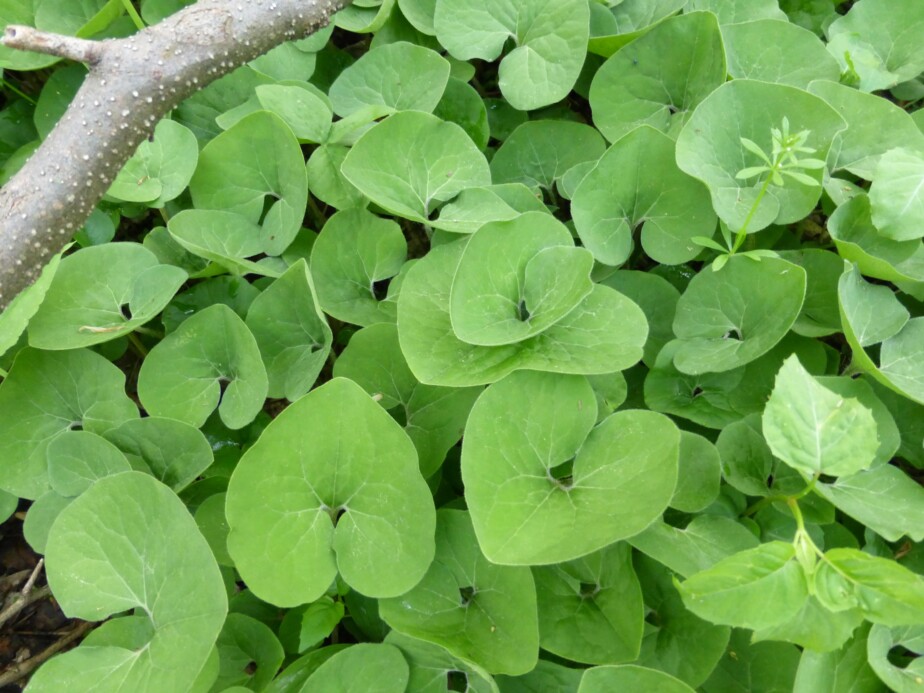
Otherwise known as ‘Candian ginger’ this wild ground cover loves shade and has various functions with blooms from April to May.
- Height: 4-8 inches
- Range: Native to Eastern North America
- Climate: Zones 3-8
- Functions: Roots have been used as digestive medicine. Ornamental value with shapely and lush-looking heart-like leaves. Best for ornamental-, edible-, or healing-oriented gardens.
- Light requirements: Ginger will grow as a ground cover under lightly shaded or deeply shaded areas. Partial to full shade.
- Soil preferences: Moist, drained, rich, and neutral-acidic soils.
Unless you can find someone with local cuttings to offer—Wild ginger can be bought and planted from bare roots on Etsy.
Creeping Jenny (Lysimachia nummularia)
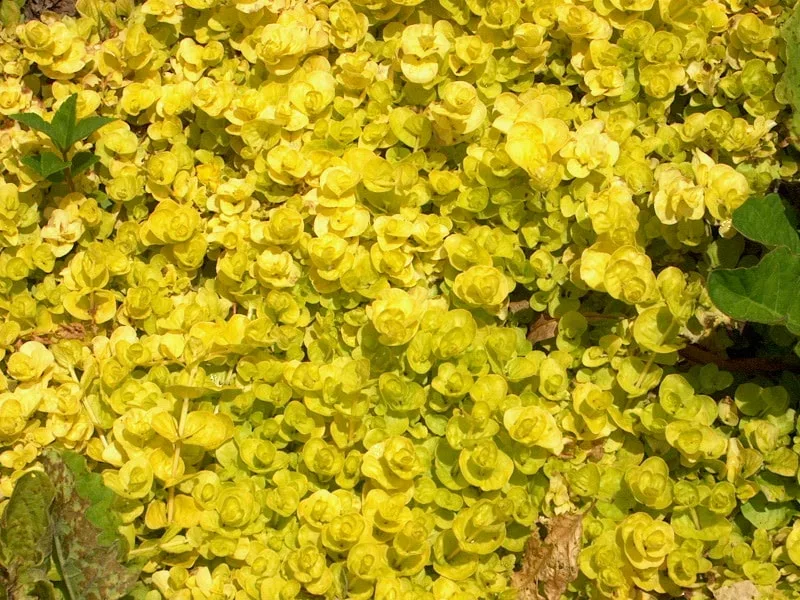
Various kinds of creeping jenny provide gorgeous ground coverage. Pictured, is bright yellow known by ‘Aurea.’ The one known by Lysimachia nummularia ‘green’ also has vibrant foliage but of a bright green shade of color.
The rounded leaves make this a popular ground cover that brightens the dark of any shade. This low-grower tolerates foot-traffic.
- Height: 3-6 inches.
- Range: Native to Europe.
- Climate: Zones 3-9.
- Functions: Ornamental ground cover flowering from June to August but provides attractive evergreen foliage. Low maintenance. Easy to grow.
- Light requirements: Partial shade is preferred. Also grows well in bright full shade. Tolerates dense full shade and will grow toward brighter areas.
- Soil preferences: Moist, boggy, or wet soil. Suitable for heavy clay.
Potted plants or seeds are available.
Related: 22 Low-Growing (Creeping) Evergreen Ground Covers
Self-Heal (Prunella vulgaris)

We grow and collect the flowers of self-heal for a nourishing tea. The taste is quite pleasant with sweet notes. The plant is also cute-looking with pretty purple flowers.
- Height: 2-6 inches.
- Range: Native to temperate climates in Europe, North Africa, and Asia.
- Climate: Zones 3-7.
- Functions: Attracts pollinators such as bees. Medicinal qualities have been described to accelerate wound healing, fevers, and more. Edible for salads or tea. Small and cute looking. Ideal for high-functioning forest gardens.
- Light requirements: Partial shade to shade.
- Soil preferences: Moist soil.
Labrador Violet (Viola labradorica)
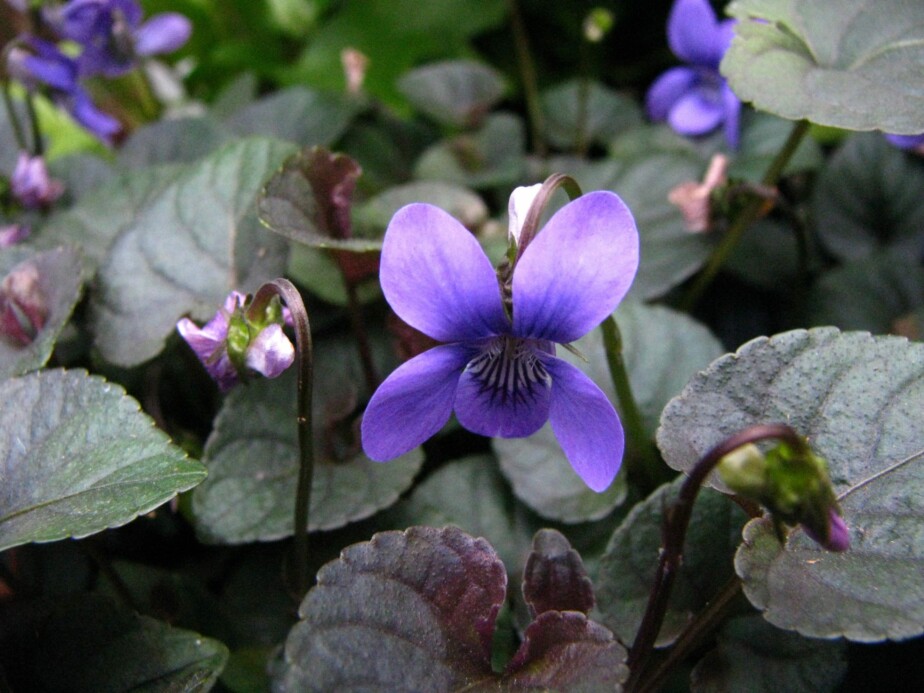
With their contrasting dark foliage, labrador violets are typically used as borders in rock gardens, food forests, or general woodland/wild gardens.
The darker foliage offers beautiful contrast to larger perennials in the -scape.
- Height: 3-4 inches.
- Range: Native to North America.
- Climate: Zones 3-8.
- Functions: Ornamental borders. Attracting butterflies. Edible flowers and leaves for salad, cooked greens, or tea.
- Light requirements: Full dense shade to partial shade.
- Soil preferences: Moist
Seeds are available here on Etsy.
Partridge Berry (Mitchella repens)

Partridgeberry is similar to bearberry in many ways but their degree of shade tolerance is a bit different. Partridge berries prefer at least partial shade. The foliage between them has clear differences but both produce little red edible berries.
Related: 19 Tasty Fruiting (Low-Growing) Ground Covers
Partiridgeberries are also popular in food forests for fulfilling the ground cover layer.
- Height: 2 inches
- Range: North America
- Climate: Zones 4-9
- Functions: Fragrant ground cover in rock gardens, native gardens, or woodland gardens.
- Light requirements: Partial shade.
- Soil preferences: Moist soil
Seeds are available here.
Hydrangea (Hydrangea anomala)
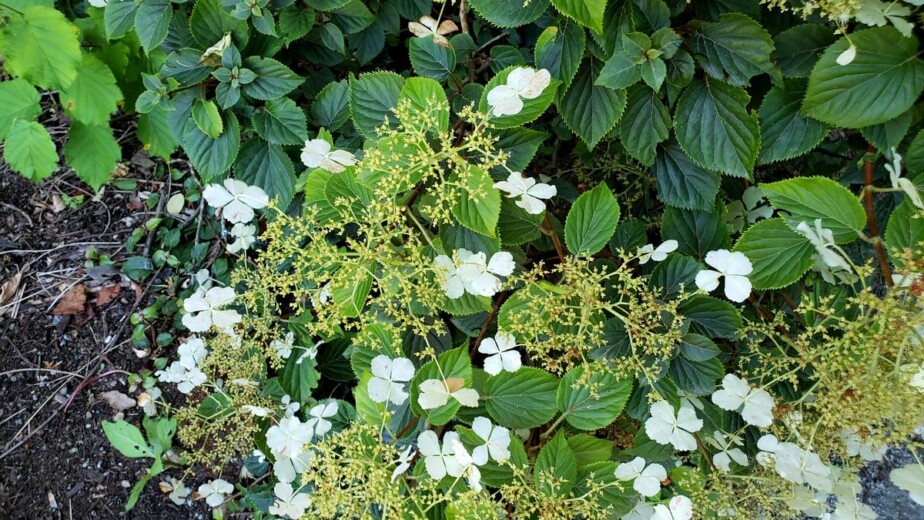
This hydrangea (anomala) is a fast-growing deciduous perennial that spreads of climbs up to 40 feet in length. It grows in full shade, partial shade, or with no shade—as long as its roots stay moist.
While native to Asia, hydrangeas are grown all over because it is favorably ornamental.
- Height: 3-4 inches
- Range: Asia
- Climate: Zones 4-8
- Functions: Ornamental—the flower color is largely affected by soil acidity and is grown for show. Leaves and sap are sweet and edible.
- Light requirements: Full/deep shade to partial shade.
- Soil preferences: Well-drained moist soils.
Find seeds here. It’s also known as “climbing hydrangea” and is available as plant starts in containers.
Periwinkle (Vinca minor)

Also called Periwinkle, this is a semi-evergreen ground cover with blue-purple flowers.
Although popular, it may be considered invasive in your area.
- Height: 6 inches
- Range: Europe and Asia
- Climate: Zones 4-9
- Functions: Ornamental flowering from April to May with season-round attractive foliage. Erosion controlling ground cover for rock gardens, food forests, steep slopes, shady areas, and borders.
- Light requirements: Full/deep shade to partial shade.
- Soil preferences: Moist or dry soil and tolerates drought. Suitable for various soil types including heavy clay.
Plants are available here and seeds are here. Ordering seeds offers pink and other flower colors, but a container allows for quicker establishment.
Up Next:
Recent Posts
There’s no shortage of full-sun ground covers for zone 4 climates! Each plant in this list can withstand the frigid temperatures and also enjoy the hot sun in summer. Full sun means that a plant...
There's no shortage of full sun ground covers, not even in zone 3! Zone 3 climates offer hot but short-lived summers and very cold winters. So each plant in this list can withstand the frigid...
